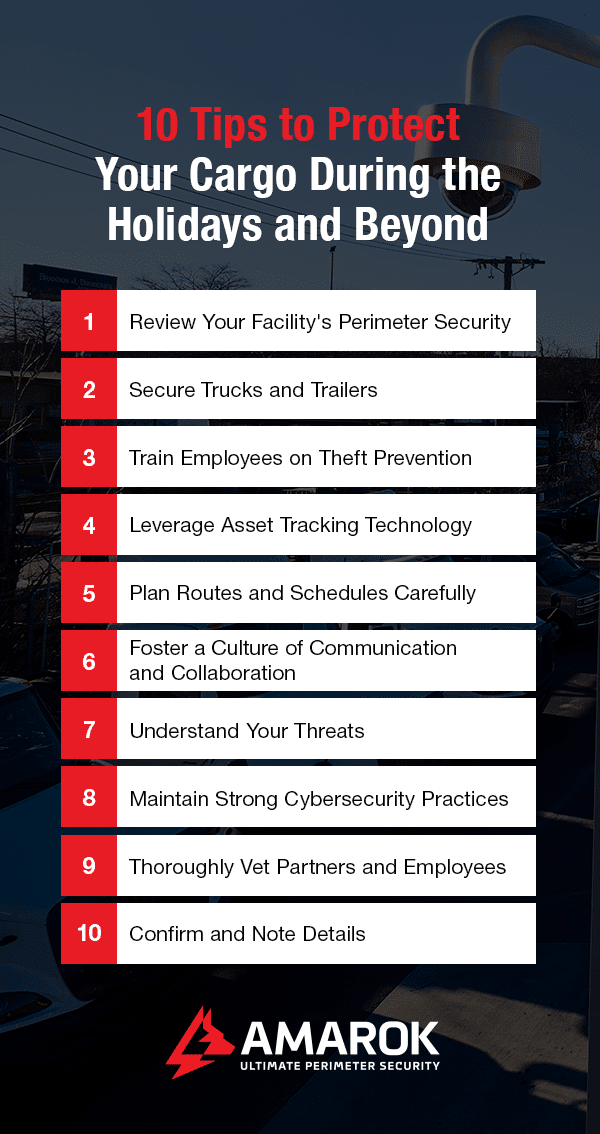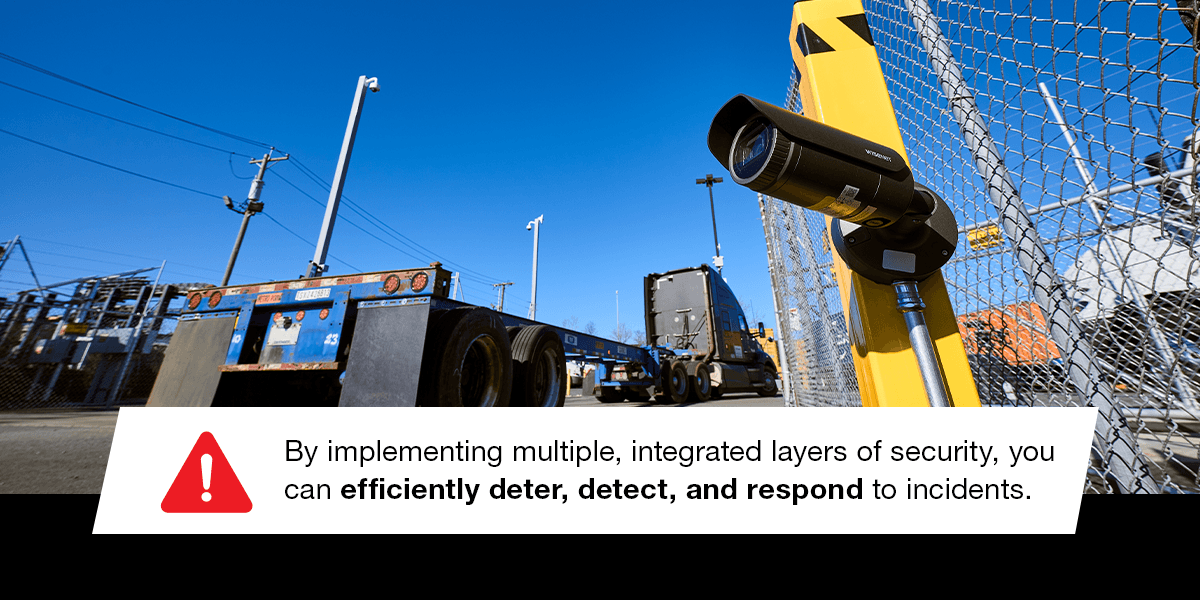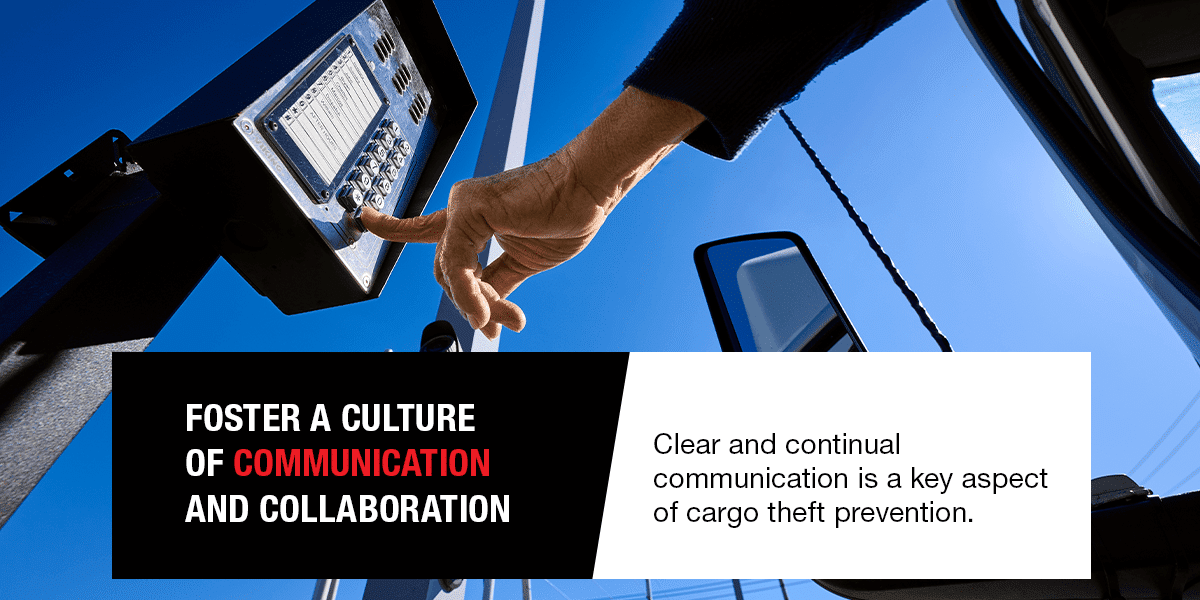Whether it’s Thanksgiving or Memorial Day, cargo crime tends to skyrocket during the holidays. For example, according to a recent CargoNet analysis, businesses face increased vulnerability during the days surrounding Labor Day.
Warehouses, truck stops, and large parking lots are the most targeted locations. Criminals are eager to steal electronics, appliances, computers, and vehicle maintenance products stored in trailers at these locations, especially as retailers order high-value inventory for holiday sales.
Why Cargo Theft Increases During Holidays
Criminals know loaded trailers often sit unattended for extended periods as drivers and warehouse employees head home to enjoy the holiday. They see unique opportunities to seize cargo or commit fraud to steal high-value goods. Unfortunately, businesses may not know they’ve lost cargo until they return to work, and this delay reduces the chance of recovering lost goods.
The Impact of Holiday Cargo Theft
Businesses impacted by holiday-related cargo theft might lose thousands or even millions of dollars per incident. CargoNet notes that the average total value of stolen goods during Labor Day week is nearly $163,000 per incident. However, this number could be much higher depending on the value and quantity of the product stolen. That’s not to mention the other consequences of cargo theft, like increased insurance premiums, decreased employee morale, and damaged reputations.
10 Tips to Protect Your Cargo During the Holidays and Beyond

Businesses can take proactive measures to effectively guard against cargo theft during holidays and every other day of the year. Consider the following tips:
1. Review Your Facility’s Perimeter Security
If you manage a warehouse, distribution center, or any other facility with a truck yard, it’s vital to consider whether you have a secure perimeter. Your property’s perimeter should prevent unauthorized access 24/7. If it doesn’t, it may be time for an upgrade. First, you’ll need to assess your property’s limits to identify the areas that need urgent attention.
Walk around your facility and consider if the perimeter is well-lit and free of hiding spots like overgrown vegetation. Also, think about whether your property is protected by a robust barrier and access control system. If your fence is damaged, rusted, loose, or shows signs of tampering, you’ll want to fix it promptly.
After inspecting your perimeter’s condition, decide whether it incorporates adequate security features. A multi-layered security approach is the most effective method of securing a perimeter. By implementing multiple, integrated layers of security, you can efficiently deter, detect, and respond to incidents.
For example, installing an electric fencing system is one of the best ways to physically and visually deter criminals from a breach. Adding integrated video surveillance cameras and remote monitoring technology allows you to detect and capture suspicious activity from anywhere. Then, you can share footage with local law enforcement to facilitate a fast response.
If you’re unsure what’s needed to keep criminals out, contact perimeter security experts for assistance.
2. Secure Trucks and Trailers
Whether on the road or in the yard, truck drivers can enhance cargo security by applying locks or seals. Even when parking in a secure lot, using locks or seals can help prevent cargo theft when loads are left unattended during the holidays.
Drivers have many options to secure their rigs, including:
- Securing trucks with air cuff or steering joint locks.
- Placing tamper-evident seals on trailer doors or other access points.
- Securing the trailer with a hardened steel, cut-resistant padlock.
- Preventing unauthorized coupling by installing a kingpin lock.
- Installing a landing gear lock on a dropped trailer.
Encourage your team to use multiple locks simultaneously, like seals and padlocks, for added security.

3. Train Employees on Theft Prevention
Your workforce plays a major role in holiday crime prevention. Whether your employees include truck drivers, fleet managers, or warehouse supervisors, it’s crucial they’re trained on the latest cargo theft prevention strategies.
During training, consider covering the following topics:
- Always locking doors and removing keys from the ignition when leaving trucks unattended
- Parking in secure, well-lit areas and in view of surveillance cameras whenever possible
- Recognizing and reacting to suspicious activity
- Understanding current cargo theft trends
- Utilizing security technology like cargo tracking devices or electronic seals
- Keeping route and driver information secure
Additionally, train employees on best practices to promptly report theft to law enforcement to increase the chances of recovering stolen cargo and minimizing loss.
4. Leverage Asset Tracking Technology
Asset tracking technology adds an important layer of security to prevent theft or limit loss. By attaching devices like GPS trackers to trailers, you can track your assets in real time from anywhere. With this capability, if you notice a driver parking in an unauthorized location or straying from a planned route, you can investigate the situation and take the appropriate action.
More specifically, you can closely monitor cargo by utilizing a telematics system. Telematics systems combine GPS technology with geofencing capabilities, telecommunications, sensors, and in some cases, onboard cameras. The system notifies fleet managers through a desktop or mobile device if cargo has crossed a predefined geofence, signifying an issue. It can also alert management of suspicious behavior, such as erratic driving, so they can react.
Depending on the telematics solution you choose, you can place connected sensors on everything from trailer doors to tires, so you’ll know immediately if tampering or theft occurred.
5. Plan Routes and Schedules Carefully
Careful route planning and scheduling help keep drivers out of high-crime areas and decrease the risk of cargo theft. In-transit cargo theft is more likely to occur in densely populated areas, especially during weekends and holidays. Likewise, some parts of the country are hot spots for cargo crime, which drivers should be aware of. Though cargo theft happens in every state, there’s a higher risk in California, Texas, and Illinois
Regardless of where your team is heading, encourage them to plan routes that minimize time in high-risk areas. Also, they should plan to stop at secure places to rest, eat, shower, or refuel. It’s recommended that drivers avoid stopping within 200 miles of picking up cargo to guard against criminals monitoring truck yards.
Consider using route planning software to optimize routes and help drivers reach their destinations efficiently so they have less time on the road or in unsafe areas. Route planning tools can also provide alternative directions in unexpected events. That way, drivers can adapt to unforeseen situations quickly and safely.
Lastly, encourage your team to be careful with scheduling. They should aim to schedule deliveries or pickups during daylight hours, when there’s greater visibility, whenever possible. During the holidays and extended weekends, it’s also essential to confirm hours of operation with shippers and receivers to ensure they’ll be open. By doing so, your drivers won’t get stuck with a load and nowhere to go, allowing them to avoid parking in public or unsecured lots.
6. Foster a Culture of Communication and Collaboration
Clear and continual communication is a key aspect of cargo theft prevention. Communicate with carriers or drivers about security concerns, discussing risks and recommendations for mitigation. Also, ensure drivers have someone they can contact 24/7 if an issue arises, including during holidays. For example, drivers should always be able to reach a familiar dispatcher to confirm route or location changes.
Additionally, make sure drivers have the tools they need, like Bluetooth headsets, to streamline communication and alert stakeholders to urgent situations.

7. Understand Your Threats
Criminals employ a wide range of tactics to steal cargo — and these strategies only continue to evolve. Knowing what you’re up against is important so you and your employees can be proactive.
Some types of cargo theft include:
- Pilfering: Opportunistic thieves may look for unattended trailers to pilfer through goods and take small amounts, which can be difficult to detect. Pilfering is common at truck stops when drivers leave their trucks to shower or eat. One way to reduce the risk of this theft is to encourage drivers to rest and eat before picking up a load. Applying high-security locks when leaving trailers unattended also helps.
- Fictitious pickups: During the holidays, employees must be prepared to identify and respond to fictitious pickup attempts. Fictitious pickups are a common cargo theft technique seen when a criminal uses forged documentation to impersonate a driver and pick up cargo. Enhanced access control can help combat fictitious pickups.
- Hijacking: Hijacking is when criminals force entry into a stopped truck, threatening the driver’s safety and stealing cargo. This dangerous form of cargo theft could be preplanned or opportunistic. Ensuring drivers don’t stop for at least 200 miles after picking up a load is one way to decrease hijacking risk.
- Double-brokering scams: Some criminals pose as freight brokers, tricking legitimate brokers into passing their cargo onto them. Then, they never deliver the shipment to the appropriate place and instead keep it for themselves to sell.
It’s also worth mentioning that organized crime rings have enhanced their evasion techniques. It’s becoming more common for thieves to steal part or all of a shipment and then switch important details like license plates and trailer numbers between multiple pickups to delay detection — all the more reason to equip your trailers with tracking technology.
8. Maintain Strong Cybersecurity Practices
The holiday season is a popular time for cybercrime. Logistics companies must look out for cybercriminals aiming to access driver information so they can carry out fictitious pickups or other types of cargo crime. For example, criminals use phishing scams to deceive employees and install malware to access driver information or reroute shipments to their chosen location.
To protect your business and its assets from cybercrime, training employees on how to recognize phishing emails and other scams is essential. Also, emphasize the importance of using secure communication channels to keep sensitive information out of hackers’ hands. Other cybersecurity measures include regularly updating system software, enforcing strong passwords, and implementing multifactor authentication.
9. Thoroughly Vet Partners and Employees
Even during the busiest holiday season, it’s crucial to vet carriers, drivers, and warehouse employees properly so you know exactly who’s handling your cargo. This practice includes running thorough background checks on employees and verifying carrier or freight broker information.
For instance, make sure a carrier has a valid MC number and review their safety ratings through a source like the Safety and Fitness Electronic Records system. Also, check references or reviews from other companies that have partnered with the carrier.
That said, vetting partners isn’t a guarantee you’ll prevent fraud like a fictitious pickup — you’ll need other protocols in place. Shippers must have a standard process for verifying driver details, such as checking their ID against documentation.
10. Confirm and Note Details
Ensure employees practice verifying load details with each shipment or delivery, which includes verifying the shipper or receiver location and expected arrival time. That way, drivers know for sure where they need to head, and receivers know who to expect.
It’s also important to record details like driver’s licenses and carrier names, using cameras or video to capture further evidence. For example, by installing video cameras and license plate recognition technology at your gate, you’ll have evidence to show police officers if criminal activity occurs, which can help you recover stolen assets.
Safeguard Your Cargo With AMAROK
Although cargo theft increases during holidays, it’s a year-round risk that can lead to significant financial loss. In the third quarter of 2024 alone, the total value of stolen cargo was over $39 million. It’s vital to protect your cargo every day of the year to safeguard your bottom line. The perimeter security experts at AMAROK can help.
We specialize in establishing secure perimeters by installing highly effective electric fencing systems. Our flagship solution, The Electric Guard Dog™ Fence, has proven to prevent external theft for 99% of our customers after installation. Truck yards, equipment rental facilities, distribution centers, and many other types of businesses rely on our electric security fences to keep criminals off their properties.
We also offer solutions like video surveillance cameras and alarm-based lighting systems that can be integrated with an electric fence to create a multilayered security posture. Our services begin with a free threat assessment so we can identify your unique security risks and help you design a solution that meets your needs.
Contact us today to schedule your assessment or discuss your security needs with a local AMAROK representative.





